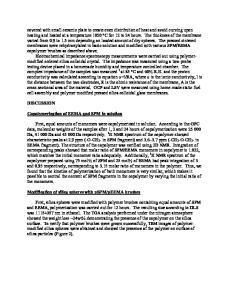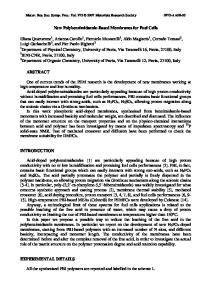PVDF-based Polymer Blend Films for Fuel Cell Membranes
- PDF / 16,964,928 Bytes
- 6 Pages / 612 x 792 pts (letter) Page_size
- 65 Downloads / 399 Views
Synthesis of Mesoporous Gadolinium Doped Ceria - Platinum Composite Hoi Yung, Kwong-Yu Chan and Frank Leung-Yuk Lam Department of Chemistry, The University of Hong Kong, Pokfulam Road, Hong Kong ABSTRACT Oxygen reduction in SOFC cathodes has long been the rate determining step in SOFC operations, mixed ionic-electronic conductors (MIECs) and/or forming composite between cathode and electrolyte materials have been common strategies in order to aid the cathode kinetics. We demonstrate here a viable synthesis route to impregnate mesopores with high loading of platinum towards a mesoscale bicontinuous material that composed of channels of a fast ionic conductor, i.e. gadolinium doped ceria (GDC) intertwined with channels of a good electronic conductor, i.e. Pt. This highly structural composite material holds the promise of a high performing cathode in SOFC. INTRODUCTION Solid oxide fuel cell (SOFC) is a very efficient electrochemical device. Its commercialization is crucial to a more sustainable energy consumption pattern based on renewable energies. Owing to its high operating temperatures (800-1000°C), expensive catalysts such platinum can be replaced. An additional feature of SOFC is the possibility to operate as an electrolyzer which splits water into its constituents with equally high efficiency 1. Therefore, SOFC can also be used as an efficient energy converter in energy storage where off peak power can be stored in the form of a chemical fuel. As operating temperature decreases to the intermediate range (600-800°C), electrode kinetics slows down significantly since all SOFC processes are thermally activated. Reduced ionic conductivity in solid electrolytes are usually compensated by making the electrolyte layer thinner The electrode kinetics is improved by using a mixed ionic-electronic conductor (MIEC) and further improved by addition of an ionic conductor such as the electrolyte material itself to aid oxygen ion diffusion 2, 3. These strategies all aims at increasing the length of three phase boundaries (tpb) where key oxygen reduction steps take place. Classic examples are La0.6Sr0.4Co0.2Fe0.8O3-δ(LSCF) and Gd doped ceria (GDC) composite studied by Dusatres, et al 2. These composite cathodes are usually made by randomly mixing the individual phases in powder form followed by partial sintering forming a porous structure that adhere to the electrolyte. The random nature of mixing is often modeled by the effective medium percolation theory (EMPT) which predicts a sharp transition of performance at a certain ratio of the individual phases. In reality, since particle sizes are not uniform and particle shape is irregular, threshold ratio is hard to be obtained. Besides, the improvement in performance is marginal partly due to the fact that each phase is not fully interconnected so that reduced oxygen ions cannot be carried away efficiently. Efforts have been made to further optimize the cathode structure, for instance, functionally graded electrodes 4 or impregnation of one phase into a porous network of another ph
Data Loading...











